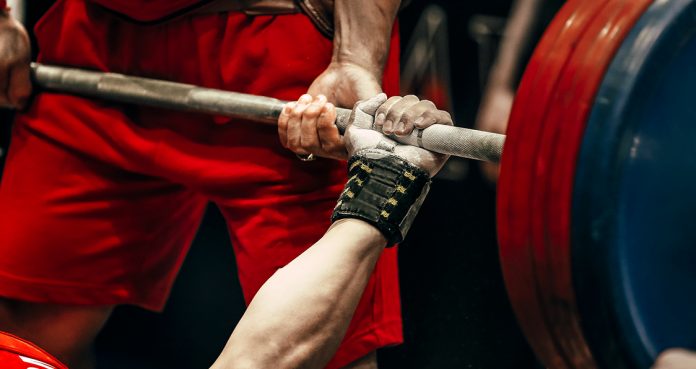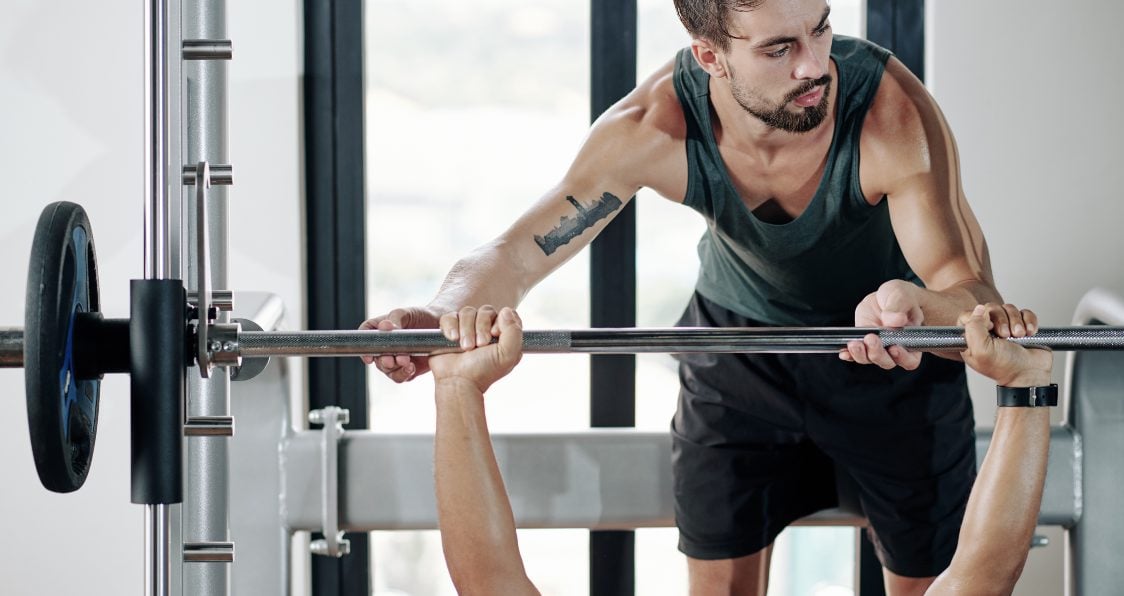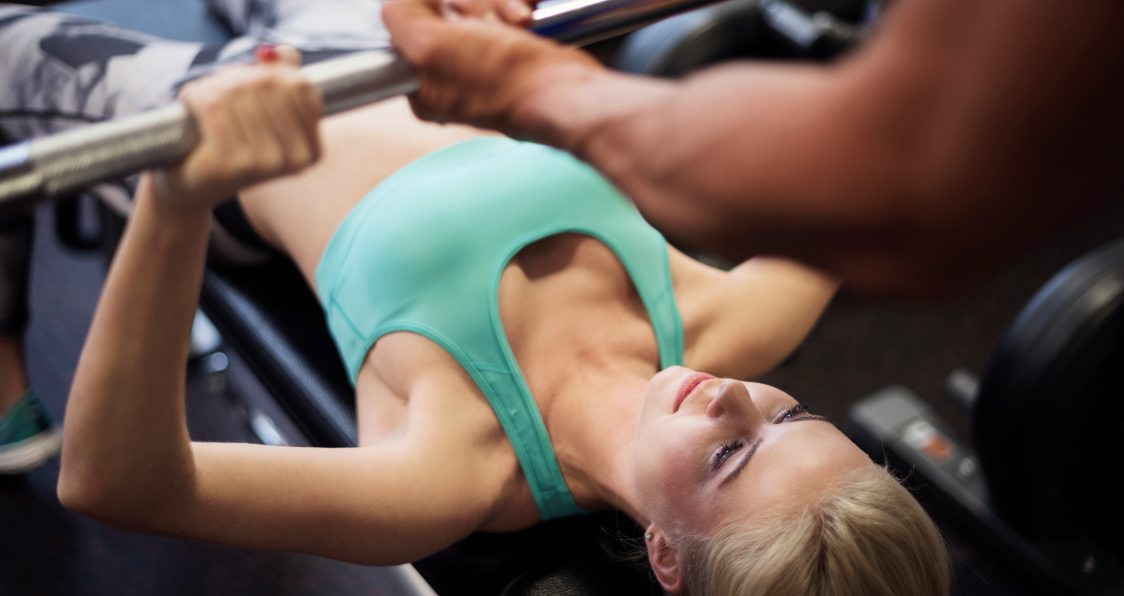
Using Bench Variations for Comprehensive Chest Gains
When it comes to developing the size and strength of the chest, there is no exercise that quite compares to the barbell bench press. There are two common barbell bench press variations that can be used to accelerate progress – the incline and decline bench press.
For optimal pectoral development, a combination of all three bench exercises should be performed.
This article will look more closely at the decline bench press, explain how to effectively perform the exercise, highlight specific benefits and provide a number of decline bench variations and alternatives.
Decline Bench Press Technique
This section will break down the technique required to effectively perform a barbell decline bench press. While some gyms may not have a bench that is designed specifically for the decline bench press, the exercise can also be performed with dumbbells.
The execution for both the barbell and dumbbell bench press is the same, however, be aware that you will be capable of lifting less weight with the dumbbell decline bench press.
To perform the decline bench press safely and effectively, ensure you follow the consequent four steps.
Step 1
Start by lying back on the decline bench and secure the feet under the pads (if pads are provided). This will prevent the body from sliding off the bench.
If you do not have a way to secure the feet, use light loads only and proceed with caution. If using heavy loads it is required to anchor the feet.
Step 2
Line the eyes up with the barbell and use a grip that is slightly wider than shoulder-width.
Before lifting the bar off, squeeze between the shoulder blades, lift the chest and engage the core muscles. Carefully lift the bar from the stand and hold it directly above the sternum.
Step 3
While maintaining this tension in the trunk, gradually move through both the elbow and shoulder joints in order to drop the bar down towards the chest.
Ensure to keep the elbows slightly down from the line of the shoulders and elbows under the wrists.
Step 4
Once the bar makes contact with the lower chest, powerfully drive the weight back upward by extending through the elbows.
On returning to the starting position, take a slight pause to reassess your set-up position before proceeding with the remaining repetitions.

Decline Bench Press Muscles Worked
While adding the decline bench press can evidently stimulate new growth in the pectoral muscles, there is an array of other muscles that are recruited during the movement.
This section will focus on the muscles that are primarily worked during the decline bench press.
Pectorals
The pectorals muscle group consists of four muscles – the pectoralis major, pectoralis minor, serratus anterior and subclavius.
These muscles connect the front of the chest to the shoulder and arms and contract to generate and stabilize movement around the shoulder joint.
The pecs are the primary mover in the barbell bench press and are subject to a great amount of stress (1).
The decline press recruits muscle fibers of the lower region of the pecs in a similar way to the incline press which places more demand on the upper region.
Anterior Deltoid
The deltoid is the muscle found in the shoulder. There are three portions of this muscle that are referred to as the anterior, middle and posterior delt.
The anterior delt can be located at the front of the shoulder and is highly active during the majority of pressing movements – including the bench press (2).
However, in comparison to the conventional and incline bench, the anterior deltoid is involved less during the decline press. This may be beneficial for lifters with shoulder issues.
Triceps
The triceps are found to the rear of the upper arm and primarily responsible for causing elbow extension.
During the press, the elbows must fully extend in order to drive the bar upwards and therefore, the triceps are heavily involved (3).
With that being said, once again the decline position reduces some of the demand on the triceps, in comparison to other benching variations and alternatives.

Decline Bench Press Benefits
Providing the decline bench press is programmed appropriately and executed well, you can expect to experience a number of benefits, some of which are detailed below.
1) Lower Chest Development
As mentioned, the decline bench press appears to place stress on the lower fibers of the chest more so than any other benching exercise.
Often the lower chest does not experience the same kind of adaptation as the mid and upper portions.
Therefore, incorporating the decline bench into your training program can allow the lagging lower chest to catch up and more comprehensively develop the chest.
2) Reduced Strain on the Shoulders
A high volume of pressing exercises can aggravate the shoulders – particularly the technique is poor or excessive weight is being lifted.
As a result, injuries to the shoulder may occur. Often when this happens, pressing exercises are removed from the training program which can lead to regression.
Using exercises such as the decline bench press can be useful for anyone struggling with shoulder issues as the movement does not place such a great demand on the anterior deltoid.
Therefore, incorporating the decline bench into your training may allow you to continue to train pressing exercises and prevent regression without irritating the shoulders.
3) Stimulating New Gains
When it comes to improving strength and size, it is important that you are gradually overloading your training. However, over time improvements may slow or even cease.
Research shows that bringing in new exercises and altering the training stimulus can have a significant impact on the rate of adaptation (4).
Therefore, if you’ve never used the decline bench press previously it may allow you to make substantial improvements in strength and size.
If you are well acquainted with the bench press, consider using it alongside a variety of other pressing and dip exercises to hit the pecs from a range of angles to maximize the rate of change.

Who Should Perform the Decline Bench Press?
While most will benefit from regularly performing the decline bench press, however, it is important to be aware that it may not be suitable for certain individuals.
Due to the decline position where the legs are placed higher than the head, circulation may be affected as a result of gravity. Consequently, lightheadedness and nausea may become a factor for some.
Always speak to a medical professional and receive clearance first if you are ever in doubt.
There are certain individuals who can highly benefit from adding this benching variation into their training.
Strength and Power Athletes
The bench press is an exercise that is required in both powerlifting and strongman events. Therefore, it makes sense for powerlifters and strongmen to utilize the decline bench press.
Although in powerlifting it is the flat bench that is used in competition, using the decline bench in training can unlock strength gains and lead to a better competition lift.
As mentioned, when it comes to maximizing strength and size gains, it is important that the muscles are targeted from a range of different angles.
Therefore, incorporating the decline variation in your strength or hypertrophy mesocycles can effectively build pressing ability, improve chest size and enhance performance.
Furthermore, there may be times where strength and power athletes need to reduce the amount of stress placed on the shoulders which again makes the decline bench the perfect choice.
Bodybuilders
One of the biggest benefits associated with the decline bench press is the development of the lower chest.
When it comes to bodybuilding, goals are aesthetically based. Bodybuilders look to build size and defined while maintaining proportions and symmetries.
Therefore, the decline variation will effectively help bodybuilders build size and definition of the lower pecs thus developing fuller-looking chests.
General Fitness Athletes
Finally, those who are looking to generally improve health, strength, and fitness can benefit from the decline bench press.
It can be particularly beneficial for increasing your pressing abilities. Developing strength through the decline bench can have a substantial impact on other pressing movements such as flat bench, overhead press, and dips.
It can also serve as a useful exercise for anyone who wishes to bench but is restricted through shoulder discomfort or injury.
Some individuals may experience issues when attempting the flat or incline bench press and therefore, the decline may be a better option as it reduces the amount of stress that the shoulders experience.
If you are unsure of your benching technique and feel discomfort, talk to an exercise professional. If you ever experience sharp pain when benching, stop immediately.

Decline Bench Variations and Alternatives
This final section will cover a number of decline bench variations and alternatives that can be used to build upper body strength.
Variations
The following two variations are progressions and should only be attempted by those who are already competent with the decline bench press.
1) Floor Bench Press with Glute Bridge
Not all facilities will have a decline bench that is suitable for barbell benching. This variation can be used to create your own decline position while simultaneously developing core strength.
Start by lying back on the floor with a bar in a rack above you. Drive the hips upwards while keeping the shoulders on the floor and hold this position.
From there, unrack the bar and press as normal while maintaining the bridge. Squeeze the core muscles and glutes throughout to help hold you in the correct position.
2) Decline Dumbbell Bench Press
Using dumbbells rather than a barbell can help to develop unilateral (single-arm) strength and enhance proprioceptive abilities such as coordination and stability (5).
Using single weights rather than a bar may increase muscle activation and consequently positively impact strength and size development.
If you are using heavy weights, ensure that you can lock the feet so that you will not slide out of position. In addition, a spotter is recommended as it can be tricky to assume the correct starting position alone.
Alternatives
The following four alternatives are regressions that should be used by those who do not have access to a decline bench or find the exercise to be overly challenging.
1) Cable Crossovers
One of the best things about the cable crossover is that they can be performed at a range of different angles.
To effectively work the lower portions of the pecs, the handles should be set at a low position so that the cables are driven upward until the handles align with the shoulders.
Cables are an excellent resistance tool as they maintain tension on the muscle throughout the duration of the exercise. Increasing time under tension can be an effective method of increasing strength and size.
2) Gironda Dips
The Gironda dip is a dipping variation that is performed on parallel or V-shaped bars. The difference between the Gironda and convention dip is the position of the elbows and hands.
In the setup, the hands should be wide and as the elbows hinge, they should be pushed out to the side rather than staying in line with the shoulders.
Effectively doing this will place a large demand on the lower portion of the pecs in a similar fashion to the decline bench press.
3) Decline Dumbbell Fly
In the same way that the bench press can be performed in an incline, flat or decline position, so too can the dumbbell flye – another popular chest developing exercise.
Assume the decline position, grab a set of dumbbells and will keeping the arms extending, gradually drop the weights to the side of the body before returning the dumbbells to the starting position.
4) Decline Push Up
Lastly, the decline push-up is a simple yet effective alternative to the decline bench press and activates the pecs in a very similar way.
To perform the push-up, simply place the feet on a bench or step and perform a set of full push-ups.
Final Word
The decline bench press is a superb developer of the chest, shoulders, and arms and can effectively build strength, size and pressing capabilities. As a consequence, it makes an excellent addition to the majority of resistance training programs.
References:
1 -Lauver, Jakob D.; Cayot, Trent E.; Scheuermann, Barry W. (2016). “Influence of bench angle on upper extremity muscular activation during bench press exercise”. European Journal of Sport Science. 16 (3): 309–316. doi:10.1080/17461391.2015.1022605. ISSN 1536-7290. PMID 25799093.
2 – Muyor, José M.; Rodríguez-Ridao, David; Martín-Fuentes, Isabel; Antequera-Vique, José A. (June 14, 2019). “Evaluation and comparison of electromyographic activity in bench press with feet on the ground and active hip flexion”. PLoS ONE. 14 (6). doi:10.1371/journal.pone.0218209. ISSN 1932-6203. PMC 6568408. PMID 31199829.
3 – Stastny, Petr; Gołaś, Artur; Blazek, Dusan; Maszczyk, Adam; Wilk, Michał; Pietraszewski, Przemysław; Petr, Miroslav; Uhlir, Petr; Zając, Adam (February 7, 2017). “A systematic review of surface electromyography analyses of the bench press movement task”. PLoS ONE. 12 (2). doi:10.1371/journal.pone.0171632. ISSN 1932-6203. PMC 5295722. PMID 28170449.
4 – Fonseca, Rodrigo M.; Roschel, Hamilton; Tricoli, Valmor; de Souza, Eduardo O.; Wilson, Jacob M.; Laurentino, Gilberto C.; Aihara, André Y.; de Souza Leão, Alberto R.; Ugrinowitsch, Carlos (2014-11). “Changes in exercises are more effective than in loading schemes to improve muscle strength”. Journal of Strength and Conditioning Research. 28 (11): 3085–3092. doi:10.1519/JSC.0000000000000539. ISSN 1533-4287. PMID 24832974.
5 – Saeterbakken, Atle H.; Fimland, Marius S. (2013-07). “Effects of body position and loading modality on muscle activity and strength in shoulder presses”. Journal of Strength and Conditioning Research. 27 (7): 1824–1831. doi:10.1519/JSC.0b013e318276b873. ISSN 1533-4287. PMID 23096062.
